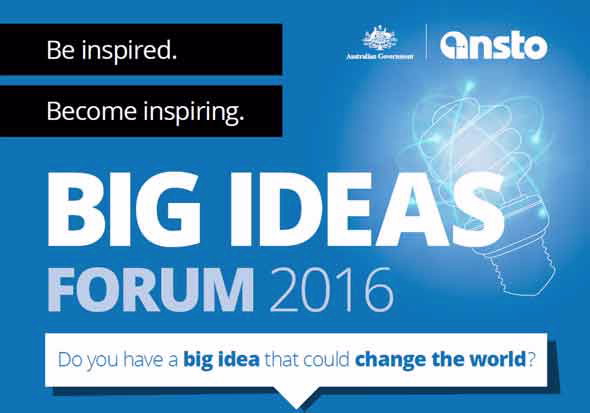
The Australian Nuclear Science and Technology Organisation (ANSTO) has today announced 22 lucky Year 10 students who will have an all-expenses-paid trip to Australia’s home of applied nuclear science.
Students posed wonderful questions for a chance to partake in the inaugural ANSTO Big Ideas Forum, with topics as diverse as dementia prevention, organ printing and harnessing human kinetic energy for power.
The inaugural ANSTO Big Ideas Forum will gather the best of these budding STEM students and their teachers from 14-18 November for a week of unforgettable learning, alongside some of our country’s best scientific minds.
The 11 pairs of students won the chance after submitting 40-second videos where they outlined the problem they hoped science would solve in the future.
“The students asked really perceptive questions about the challenges of the future, which has been great to see,” said Rod Dowler, Discovery Centre Leader and coordinator of the ANSTO Big Ideas Program.
“ANSTO Big Ideas Forum is about empowering them to push boundaries, and not confine themselves to being ‘just students’ – their ability to contribute is vast and we want to give them every opportunity.
“Everyone is already busily preparing to welcome our 22 new young scientists, and 11 science teachers, and to get them in amongst all the action and excitement here at ANSTO.
“These are the first students in this program, and it will be exciting to see how kids from across the country, with very different interests and backgrounds, can collaborate and enhance each other’s learning.
“The teachers will also have a specially designed program of professional development workshops and practical experiences in ANSTO’s unique facilities.
“The students are getting ready to choose senior subjects, and hopefully the ANSTO Big Ideas Forum will provide them with a great opportunity to see what a career in science or engineering could look like.
“Curiosity is the key to succeeding in innovative research and our 22 students have already proven they have that. It will be wonderful to see it grow and flourish over the week.”
Further information: ANSTO Big Ideas Forum.
Details of the students and schools selected:
STUDENTS AND SCHOOLS ATTENDING THE ANSTO BIG IDEAS FORUM
ACT
Neve and Piper from Amaroo Senior School want to know whether dementia could be prevented by inhibitors currently used for treatment.
NSW
Katie and Julia from Calrossy Anglican School in Tamworth NSW, asked whether the food crisis could be solved by vaporising food like clouds and letting it ‘rain’ in areas of need.
Callum and Chantelle from Narara Valley High School on the Central Coast, were curious about the human body’s kinetic energy, and if it could be transformed into a renewable energy source.
NT
Cliffy and Luciano, from Yuendumu School in the Northern Territory wondered about the effects of processed of foods, and changes to diet over time.
SA
Eliza and Clayton from Kingston Community School want to know whether 3D printing of organs, tissues and neural pathways can use a patient’s own DNA to help recover from, for example, spinal injuries.
Anais and Ria from Henley High School both want to prove what their careers in STEM could mean, proposing that one day, we could implant information similarly to how a USB does in a computer.
TAS
Elena and Hugh from Rose Bay High School were inspired after the chaos of the Olympic Games, and wonder whether wearable tech and prosthesis could be common practice in everyday life to enhance performance.
Chloe and Kimberley from New Norfolk High School want to know whether methane gas from cows could be eliminated, to ensure the thriving dairy industry can continue without contributing to climate change.
QLD
David and Vivian from the Queensland Academy of Science, Mathematics and Technology want to know whether there could be a way for nuclear energy to be produced without the current side effects.
WA
Allegra and Trinity from Bunbury Catholic College want to investigate whether you could use quantum entanglement to reduce time delays when communicating with planets beyond our Solar System.
Jayde and Lewis from St Joseph’s School asked whether it would be possible to revive Mars as a life-sustaining planet by transporting Earth materials to Mars.
Media contact: Phil McCall 0438 619 987
Published: 26/10/2016


